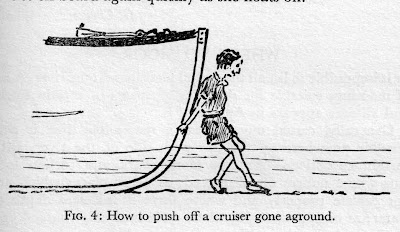
Frontispiece
The book contains some stylised maps of the river with the location of locks, bridges and services that include petrol, Calor Gas and Bottogas (what happened to that brand?). Appendices include a list of shopping places with early closing days (remember them?), the location of sewage and refuse disposal, and rather usefully a list of railway stations close to the river.

Typical map of the river

Some important mooring locations
note that dairies are shown
One of the features of the book is the chauvinist comments on boat handling made by the author. Essenn refers to frayed ropes as being Irishman’s pennants, and to towels hung on deck-rails as "flapping in the wind like a French warship". The First Aid kit is recommended to contain a pair of scissors which you “shouldn’t let your wife borrow” and he refers to the stern of a boat when manoeuvring as “swinging like women walking”!
In terms of dated information, costs are obviously one area that provides some interest. The annual licence for a 30-40 ft boat cost £7 in 1951, but there were also lock tolls. A season’s lock pass for all locks cost £15 for a 30-40 ft boat but you could pay less by using getting a pass for certain numbers of locks. Essenn estimates that mooring at a boat yard could cost up to 12/6d per week.
Although you get the impression that the galley is not his forte, Esseen does have a chapter on Domestic Economy. He recommends that you don’t take too many tinned foods (bulky & heavy) and recommends that a water-evaporation refrigerator (Kepkold) is used. He recommends putting beer in a bucket lowered into the river to cool it. He also suggests that spare milk bottles are kept on board because new bottles are not usually supplied to strangers; obviously a shortage of glass bottles.
War-time related references include mention of the need to take ration books and identity cards, and that an ex-army gas cape could keep you dry if it rained. Biscuits could be kept in ex-army small arms munitions tins which with rubber seals cost 2/6d. Chemical toilets are mentioned but there is an intriguing reference to an electric toilet which works by electrolysis and requires salt to be added to the contents.
For some strange reason Essenn provides drawings for a handy refuse bucket that can be fitted to a galley locker door. He refers to electric lights (I can remember caravans at this time using gas mantles) but he warns against leaving them on too long. To start a petrol engine he usefully points out that you could use torch batteries to supply power to the coil and hand cranking. There is no mention at all of diesel power.

Important cruiser equipment (in 1951)
An intriguing passage is that where Essenn describes how to recover from going aground. If all else fails he recommends a crew member getting into the water and pushing off from the bows. In the charming diagram used to illustrate this technique it looks like a female member that is carrying this out!

How to free a cruiser that has run aground!
All in all, this little somewhat idiosyncratic book provides a fascinating glimpse into boating at a time of national austerity.